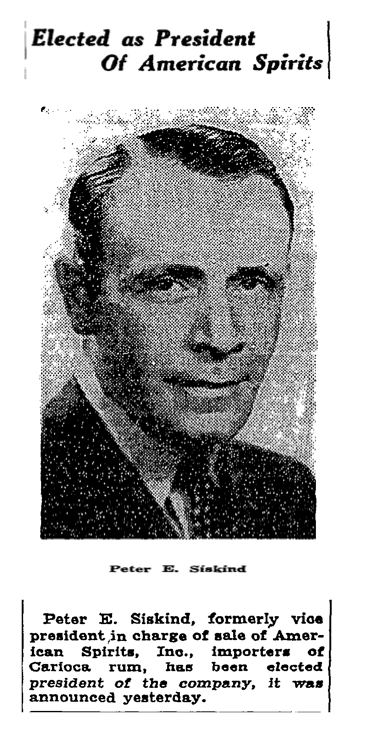Peter Siskind was the President of American Spirits
Revised interpretation of American Spirits
I was wrong about several things in the preceding posts. I said that Kessler owned American Distillery but that's wrong. American was a long standing distillery in Pekin IL that had been doing business as American Commercial Alcohol Corporation during Prohibition.
As it prepared to enter the new spirits industry when Repeal went into effect, it would need a New York sales and marketing agent to bring its whiskey brands to the market. This was similar to how other fledgling liquor companies like Seagram's and Schenley were organized, matching up refurbished distilleries in Kentucky, Indiana and Illinois with smart, mainly Jewish, businessmen inventing a new industry.
American Distillery had brought in a seasoned executive Russell Brown as president. I believe it was his strategy to create a subsidiary called American Spirits. The first president of American Spirits was Joseph H. Kraus. Peter Siskind was vice president of sales. Walter Ruby is referred to as advertising manager in one article but that may have been descriptive of his role but not his actual title.
Now a new liquor company needed a full range of liquor products. They produced their own bourbon and rye whiskey, but they needed import deals for Scotch and Irish whiskey, wines and liquors from around Europe, and rum from the West Indies.
In two 1937 articles from the NY Times business pages we see the company rolling out new strategies for their line of Scotch whiskeys and Puerto Rican rum. For the Scotch deal, they are distributing existing brands of whiskey, but for their rum play they worked with a new supplier and decided to establish a new brand.
That was Sidney Kessler and Carioca. He had taken over a rum making plant in Catano, outside of San Juan, just down the road from the main Bacardi distillery, and there he established his new Compania Ron Carioca. Doing so must have required some substantial resources, so I wonder if American Distilling didn't back the project and own a piece of it from the start.
Walter appears in that July 31, 1937 article. The Carioca Cooler is one of three drink concoctions that the company will be promoting. As far as I know, we don't have a date for when Walter left the company, whether it was shortly after the campaign launch or later that year or next. The date of his death is July 23, 1939.
The next several years show rapid growth in sales for American Spirits, especially the rum business, where it has had a hit with its new rum drink, the Carioca Zombie. The partnership between Kessler and American had gone so well that now it made sense to actually tie the knot, or at least that was what Peter Siskind thinks. The ambitious salesman engineers a deal for American to acquire Carioca for a 50 percent interest in the combined company, with the 50 percent to be split between Kessler and himself.
Peter Siskind becomes president of American Spirits on February 20, 1941 (see the NY Times clipping above). The business continues to grow, though shortages loom as the government puts all distilleries on producing industrial alcohol for the war effort. Kessler begins dreaming about his hotel and thinks it's time to cash in.
The buyer is Schenley, one of the big four liquor companies, for a rumored $4 million. Schenley continues to sell Carioca alongside other rum brands. American goes back to its knitting as a distiller for a time, though it makes a belated unsuccessful attempt to take over Schenley in the 1970s. Eventually, Schenley will be acquired by Guinness, the U.K. beverage giant.
We know that Kessler's million went into the Virgin Isle, and it paid off handsomely when after a decade of running the hotel he sold Hilton the long term license to operate it.
I haven't tried to track down Peter Siskind yet. He may have made out the best of all, having earned his cut by putting the deal together and by running the company successfully.
That's my current reconstruction of events. I'm sure I still have some things wrong, but this is getting closer.

